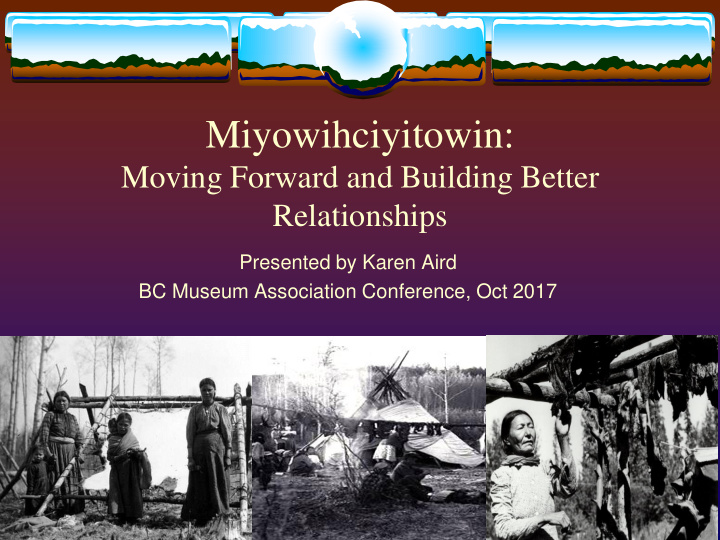



Miyowihciyitowin: Moving Forward and Building Better Relationships Presented by Karen Aird BC Museum Association Conference, Oct 2017
Rod Naknakim’s 4 specific steps: 1. Ownership of First Nations artifacts and remains is in the Indigenous peoples; 2.Opportunity for museums to decolonize the museums by partnering with the Indigenous owners; 3. Space for greater respect and effect for Indigenous peoples and a more authentic experience for museum goers; 4. Costs for repatriation of artifacts and remains should not be born by the Indigenous peoples.
What can guide your efforts to build better relationships with Indigenous people; decolonize your organizations; and develop culture centred programs and approaches that are more inclusive and collaborative to Indigenous people?
Presentation – 3 parts ❖ 1. Thinking about Miyowihciyitowin ❖ The Stories ❖ 2. Gap and challenges ❖ 3. Moving forward?
Part One: Miyowihciyitowin & The Stories
Tse’K’wa Tse’K’wa
About Tse’K’wa (Evidence and Meaning) Occupancy Ceremonies
"Jumbie Say Used To Be All Kinds Of Animals Talking:” Crow Story, Onli Nachi Stories Story 1: Crow Told by Augustine Jumbie Documented by Robin Ridington Painting by Val Napoleon Translated by Liza Wolf (August/1967 at Trutch, B. C.
Reflection M ore significant: • Artifacts that are 10,500 years old? • Legal traditions, principles, protocols, stories, spiritual believes and practices? • Current and past uses? Can you understand Tse’K’wa without these linkages? How do we ensure that future studies are at this depth level of research and are lead by or in collaboration with the Indigenous caretakers? What is the comfortable Intersection?
Story 2: The Octopus From the Walrus Magazine, May 12, 2006 by Charles Montgomery
End of Stories – Reflection What are the octopuses of today? Who are the information priests? Does one individual have a right to speak for his/her community, nation, clan and/or family Consider: • How do I frame the context of the people and heritage of which I am working? • How and what we decide to research, store, showcase and protect are the product of the political context of the day.
Part Two: Gaps and Challenges
Part 3: Moving Forward
Seven Recommendations 1. Look to Indigenous Legal Traditions, protocols and principles to understand, protect/conserve and interpret history, knowledge, objects and the caretaking of ancestors.
Tk’emlups te Secwepemc Residential School Photo by Teddy Gottfriedson
2. Embrace Indigenous groups as real partners with the same engagement process and funding.
3. Hire and provide training and employment opportunities for FNs at all staff and executive levels
4. Incorporate Cultural competence, safety, awareness and cross cultural training into your organization.
5. Engage directly with the knowledge keepers.
6. Support groups efforts to protect and educate about their cultural heritage places
7. Support Indigenous Lead Organizations for Culture and Heritage ❖ Incorporated in February 2016 ❖ National scope ❖ Not-for-profit ❖ Indigenous-designed and -led corporation ❖ Operating exclusively to date through volunteer efforts and sponsorship for direct costs of forums in Ottawa and Vancouver
IHC Objectives ❖ Resource and place of dialogue ❖ Leverage expertise ❖ Contribute to conversations ❖ Maintain a watch on policy matters ❖ Provide guidance and advice to advance their CH interests ❖ Strengthen Indigenous voices
Conclusion Why these stories are important? They are more than stories. They help transition from colonial systems of interpreting and managing heritage to allow for space and an opportunity to understand and perhaps reframe the consequences and protections from an Indigenous perspective.
Kinanâskomitinâwâw / Miikwecc, / Marcee / Nia:wen / Qujannamiik / Thank you / Merci Painting by Alex Janvier
Recommend
More recommend